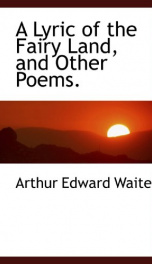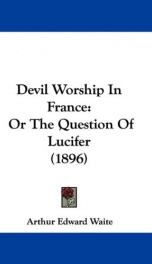Waite Arthur Edward

Arthur Edward Waite (October 2, 1857 – May 19, 1942) was a scholarly mystic who wrote extensively on occult and esoteric matters, and was the co-creator of the Rider-Waite Tarot deck. As his biographer, R.A. Gilbert described him, "Waite's name has survived because he was the first to attempt a systematic study of the history of western occultism — viewed as a spiritual tradition rather than as aspects of proto-science or as the pathology of religion."[1] Waite was born in the United States.[2] Waite's father, Capt. Charles F. Waite, died when he was at a very young age, and his widowed mother, Emma Lovell, returned to her home country of England, where he was then raised.[3] As they were not well off, Waite was educated at a small private school in North London. When he was thirteen, he was then educated at St. Charles' College.[4] When he left school to become a clerk he wrote verse in his spare time. The death of his sister, Frederika Waite, in 1874 soon attracted him into psychical research. At twenty-one he began to read regularly in the Library of the British Museum, studying many branches of esotericism. When Waite was almost thirty years old, he married Ada Lakeman (also called 'Lucasta') and they had one daughter, Sybil Waite.[5] Some time after Lucasta's death in 1924, Waite married Mary Broadbent Schofield. He spent most of his life in or near London, connected to various publishing houses, and editing a magazine The Unknown World. A.E. Waite joined the Hermetic Order of the Golden Dawn in January 1891 after being introduced by E.W. Berridge.[6] He became a Freemason in 1901,[7] and entered the Societas Rosicruciana in Anglia in 1902. The Golden Dawn was torn by further internal feuding until Waite's departure in 1914; later he formed the Fellowship of the Rosy Cross,[8] not to be confused with the Societas Rosicruciana. By that time there existed some half-dozen offshoots from the original Golden Dawn, and as a whole it never recovered.[9] Waite was a prolific author with many of his works being well received in academic circles. He wrote occult texts on subjects including divination, esotericism, Rosicrucianism, Freemasonry, black and ceremonial magic, Kabbalism and alchemy; he also translated and reissued several important mystical and alchemical works. His works on the Holy Grail, influenced by his friendship with Arthur Machen, were particularly notable.[10][11] A number of his volumes remain in print, the Book of Ceremonial Magic (1911), The Holy Kabbalah (1929), A New Encyclopedia of Freemasonry (1921), and his edited translation of Eliphas Levi's Transcendental Magic, its Doctrine and Ritual (1896) having seen reprints in recent years. Waite is best known as the co-creator of the popular and widely used Rider-Waite Tarot deck and author of its companion volume, the Key to the Tarot, republished in expanded form the following year, 1911, as the Pictorial Key to the Tarot, a guide to Tarot reading[12]. The Rider-Waite-Smith tarot was notable for being one of the first tarot decks to illustrate all 78 cards fully, in addition to the 22 major arcana cards. Golden Dawn member Pamela Colman Smith illustrated the cards for Waite, and the deck was first published in 1909.
do you like this author?
What readers are saying
What do you think? Write your own comment on this book!
write a commentWhat readers are saying
What do you think? Write your own comment on this author!
write a commentBook list

Devil-Worship in Franceor The Question of Lucifer
Series:
Unknown
Year:
Unknown
Raiting:
2.5/5
Show more
add to favoritesadd In favorites

the life of louis claude de saint martin the unknown philosopher and the subst
Series:
Unknown
Year:
Unknown
Raiting:
4/5
Show more
add to favoritesadd In favorites

the collected poems of arthur edward waite volume 2
Series:
Unknown
Year:
Unknown
Raiting:
2.5/5
Show more
add to favoritesadd In favorites
Book list

Devil-Worship in Franceor The Question of Lucifer
Series:
Unknown
Year:
Unknown
Raiting:
2.5/5
Show more
add to favoritesadd In favorites

the life of louis claude de saint martin the unknown philosopher and the subst
Series:
Unknown
Year:
Unknown
Raiting:
4/5
Show more
add to favoritesadd In favorites

the collected poems of arthur edward waite volume 2
Series:
Unknown
Year:
Unknown
Raiting:
2.5/5
Show more
add to favoritesadd In favorites

the collected poems of arthur edward waite volume 1
Series:
Unknown
Year:
Unknown
Raiting:
3/5
Show more
add to favoritesadd In favorites

strange houses of sleep
Series:
Unknown
Year:
Unknown
Raiting:
4/5
Purchase of this book includes free trial access to www.million-books.com where you can read more than a million books for free. This is an OCR edition with typos. Excerpt from book: THE SCARLET SWAN Here is high teaching from the far blue lift, For Madeline, sweet maid of Mary's gift, By certain stars transmitted on a beam Of argent splendour through a lilac haze ; A legend of the land which is not dream Or waking, as of eyes in earthly ways, Under the crimson splendours of the morn, But something greater which from both is born And far o'er life abides, in joyful stress, Full of high state and thoughtful solemness. Now list! That Madeline of white and red Rose blooms was wrought, who doubts ? The wise have said And the gold hair, assuredly, of her Shone once upon the King-Sun's royal head, As all the elfin parables aver, Whence sunshine loves so well to brood thereon; But all of scarlet was the Flying Swan Which, on the day that Madeline was made, God in such glory of bright plumes array'd, And so commission'd over starry tides Saying:Dear heart, have courage, a rest abides ! Now thus it is that through the breathless deeps Of heaven's great space upon his flight he keeps : Star after star upon the Scarlet Swan, Pours floods of light, and ever and anon, Athwart his path, the comets with a crash Hurtle, the falling meteors seethe and flash ; Dark worlds, bereft of all the fire within, Blind in the void about him feebly spin; And where in luminous mists the starry seeds Show myriad points of light, swift-wing'd, he speeds. Must he not weary ? For deep rest indeed Longs he not, dreaming of the waters cool, The clear brown stillness of some shaded pool, A nest engirded by a world of reed ? I know at least, with keen eyes fix'd before, And fill'd with frighten'd longing, evermore He labours night and day to reach his end; On Madeline, of Mary's gift, alone, As legends tell, for help his wings depend, Lest he faint somewhere ...
Show more
add to favoritesadd In favorites

saint martin the french mystic and the story of modern martinism by arthur ed
Series:
Unknown
Year:
Unknown
Raiting:
3/5
Show more
add to favoritesadd In favorites

alchemy the turba philosophorum or assembly of the sages called also the book
Series:
Unknown
Year:
Unknown
Raiting:
2.5/5
PREFACE.'HE Turba Philosophorum is indisputably themost ancient extant treatise on Alchemy in the Latin tongue, but it was not, so far as can be ascertained, originally written in Latin ; the compiler or editor, for in many respects it can scarcely be regarded as an original composition, wrote either in Hebrew or Arabic; however, the work, not only at the present day, but seemingly during the six or seven centuries when it was quoted as an authority by all the alchemical adepts, has been familiar only in its Latin garb. It is not, of course, certain that the original is irretrievably lost, the Arabic and Syriac manuscripts treating of early chemistry are preserved in considerable numbers in the various libraries of Europe, and have only been imperfectly explored. Unfortunately, the present editor has neither the opportunity nor the qualifications for undertaking such a task.There are two codices or recensions of The Turbo. Philosophorum, which differ considerably from one anotheAbout the Publisher Forgotten Books is a publisher of historical writings, such as: Philosophy, Classics, Science, Religion, History, Folklore and Mythology.Forgotten Books' Classic Reprint Series utilizes the latest technology to regenerate facsimiles of historically important writings. Careful attention has been made to accurately preserve the original format of each page whilst digitally enhancing the difficult to read text. Read books online for free at www.forgottenbooks.org
Show more
add to favoritesadd In favorites

a lyric of the fairy land and other poems
Series:
Unknown
Year:
Unknown
Raiting:
2.5/5
A Lyric Of The Fairy Land, And Other Poems. Many of the earliest books, particularly those dating back to the 1900s and before, are now extremely scarce and increasingly expensive. We are republishing these classic works in affordable, high quality, modern editions, using the original text and artwork. --This text refers to an alternate Paperback edition.
Show more
add to favoritesadd In favorites

Devil-Worship in France
Series:
Unknown
Year:
Unknown
Raiting:
2.5/5
“The term Modern Satanism is not intended to signify the development of some new aspect of old doctrine concerning demonology, or some new argument for the personification of the evil principle in universal nature.” By Arthur Edward Waite, an English mystic, occultist and prolific writer on Masonic and esoteric subjects is best known however by the creation of the Tarot deck.
The book touches upon the question of the Leo Taxil stupendous hoax and the surrounding mystery, beginning with the role of Modern Satanism and its alleged relationship to freemasonry.
Show more
add to favoritesadd In favorites
The book touches upon the question of the Leo Taxil stupendous hoax and the surrounding mystery, beginning with the role of Modern Satanism and its alleged relationship to freemasonry.
Show more
What readers are saying
What do you think? Write your own comment on this author!
write a commentif you like Waite Arthur Edward try:
readers also enjoyed
What readers are saying
What do you think? Write your own comment on this author!
write a commentGenre
if you like Waite Arthur Edward try:
readers also enjoyed
Do you want to exchange books? It’s EASY!
Get registered and find other users who want to give their favourite books to good hands!

